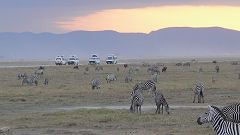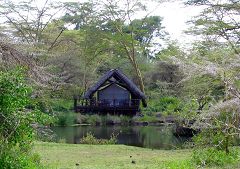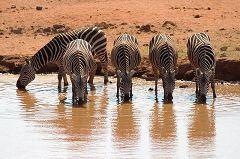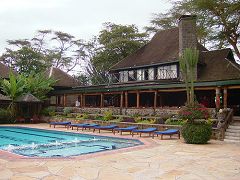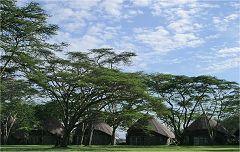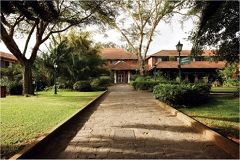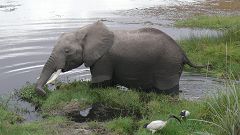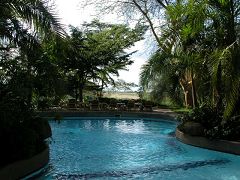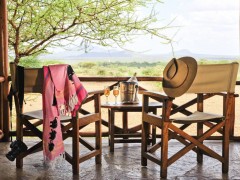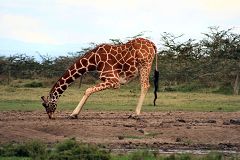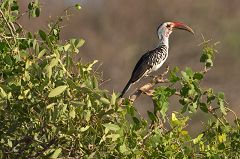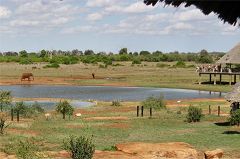 map of Kenya (loading...), the must see in Kenya
map of Kenya (loading...), the must see in Kenya
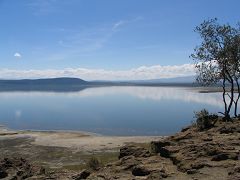
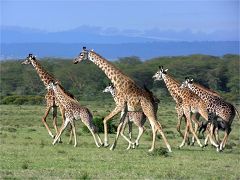
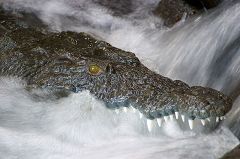
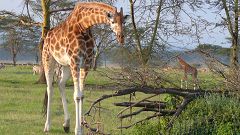
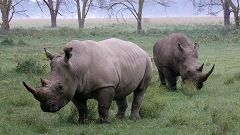
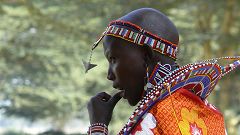
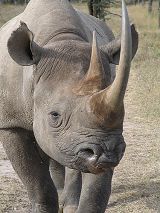
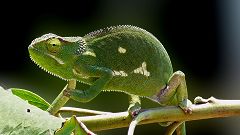
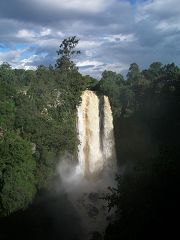
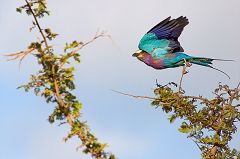 [...]
[...]
Eastern Kenya is dominated by the massive reserves of Tsavo East and West comprising 10million acres of pure wilderness. A land of wide expanses of red earth, spectacular lava flows and crystal clear springs. The two Tsavo's are divided by the Mombasa-Nairobi road/railway.
Amboseli is famous for its great game and scenic beauty with Mt. Kilimanjaro dominating the landscape: wide open plains, acacia woodland, rocky thorn bushes, swamps and marshland.
Day 1 - Nairobi
Arrival in Nairobi Jomo Kenyatta Intl Airport and transfer to town hotel Either Holiday Inn, Country Lodge, Panafric Hotel, The Norfolk.
Day 2 - Sweetwaters
Departure from hotel in the morning and drive towards Sweetwaters Sanctuary. Arrive end morning Lunch at the camp. breakfast visit the 200 acre Sweetwaters Chimpanzee Sanctuary, where orphaned chimps are rehabilitated. Visit to Morani - the 33 year old tame black rhino - and Ereri Multicultural Manyatta. Game-drive. Dinner & Overnight Sweetwaters tented Camp
Day 3 - Lake Nakuru
After breakfast drive via Nyahururu ( Thomson Falls) towards Lake Nakuru Picnic lunch enroute Arrive at Nakuru in the afternoon. Game drive.Dinner & Overnight at Flamingo Hill tented Camp or Lake Nakuru Lodge
Day 4 - Naivasha
Early morning game-drive followed by breakfast at the lodge/camp. After breakfast drive towards Naivasha. Lunch at the Naivasha Sopa Lodge or Naivasha Simba www.marasimba.com Afternoon boattrip on the Lake and optional walk at Crescent Island Sanctuary. Dinner & Overnight at Naivasha.
Day 5 - Amboseli
After breakfast drive towards Amboseli National Park. Arrive at lodge around lunchtime: Ol Tukai Lodge or Amboseli Serena Lodge. Afternoon game-drive. Dinner & Overnight in Amboseli.
Day 6 - Amboseli
Early morning game-drive followed by breakfast at the camp. After breakfast visit to Masai Village optional (additional cost). Lunch at the lodge. Game-drive in the afternoon, according to clients wishes and agreement with driver, you can reach the Observation Hill from where you can have a extremely wide-look to the plains and the Enkongu Narok Swamp. Elephants and buffalos are likely to be seen. Dinner & Overnight Amboseli
Day 7 - Tsavo West
After breakfast depart from Amboseli. Drive towards Tsavo West National Park. Visit Mzima Springs and arrive at the lodge/camp around lunchtime. Afternoon game-drive. Dinner & Overnight Kilaguni Lodge www.serenahotels.com Severin Safari Camp www.severin-kenya.com. Ngulia Safari Camp. Tsavo West is one of the most beautiful and diverse parks of Kenya. The Park offers amazing views and consists of lots of hills and mountains especially in the Ngulia area (Ngulia Valley) Game is good. A visit to Mzima Springs is definitely worth it, this is a spring which supplies the coast with water, many hippos and crocodiles. Other nice areas; Chaimu Crater and Shetani Lava Flow
Day 8 - Tsavo West to Tsavo East
Early morning game-drive followed by breakfast at the lodge/camp. Proceed to Tsavo East National Park. Game-drive enroute to the lodge/camp. Arrive in time for lunch or picnic lunch enroute. Dinner & Overnight at Voi Safari Lodge. Epiya Chapeyu Camp www.epiya-chapeyu-camp.com . Despite of its name, Tsavo East National Park is again completely different from Tsavo West. In Tsavo East there are several must-see areas, like Aruba Dam, Mudanda Rock & Lugards Falls
Day 9 - Tsavo East to Mombasa
Early morning game-drive followed by breakfast at the camp/lodge. After breakfast start the journey down to the coast. Arrive at your hotel early afternoon.
point of interest
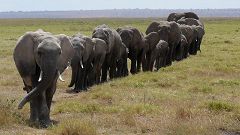
Elephants in Amboseli
Amboseli National Park is home to numerous animals including large populations of elephant, buffalo, cheetah, lion, leopard, giraffe and gazelle.

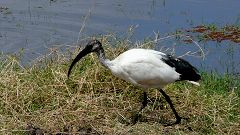
Sacred Ibis
The Sacred Ibis normally feeds on wetlands but often scavenges for food around human habitation. It's quite easy to distinguish it from the other Kenya's Ibises due to its white wings black-fringed all the way around.


Barack Obama's father origins
Barack Obama was born in Hawaii in the 1961, son of a Kenyan father and American mother (Ann Dunham) who had met at the University in Honolulu. Not a great love story: they split up when Barack was only two. His father returned to Africa and worked as a civil servant for the Kenya's President Jomo [...]

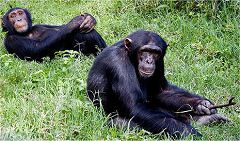
Chimpanzee Sanctuary
The Sweetwaters Chimpanzee was originally estabilished in 1993 in order to receive and shelter a group of three orphaned chimps .In 1995, nine older chimpanzees arrived, followed - at the beginning of 1996 - by a younger cub of ten. The Sweetwaters sanctuary is holding now fourty chimps and the annual cost for taking care of each of them approximates to 6.000 dollars. [photo: Nick Fraser]

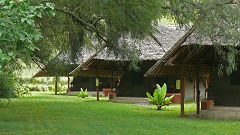
Flamingo Hill tented Camp
The twenty-five tents of the camp are all furnished with the understated luxury required by the modern traveler. Decorated with natural natural woods, wrought iron and crisp cottons each tent has been meticulously planned to maximise comfort.

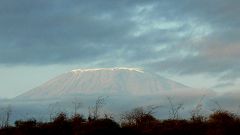
Kilimanjaro
One of the most amazing aspects of the Kilimanjaro (5.890 meters) is the accessibility of its peak to climbers with no mountain climbing equipment. It takes more or less five days to reach the top and return.

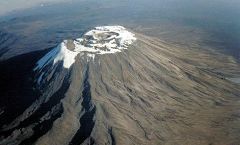
Kilimanjaro
The snow top of the Kilimanjaro in the background, as seen from the Amboseli Observation Hill

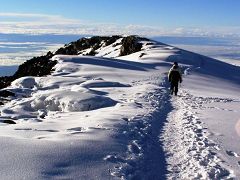
Kilimanjaro
With its 5.890 meters, Kilimanjaro is the highest mountain that regular tourists can climb, although it remains a considerable feat of human endurance. The breathable oxygen at the top is less than half the amount than is common at sea level, and climbers cover at least eighty kilometres on nothing but their own feet. [photo: Laura Weinkam]

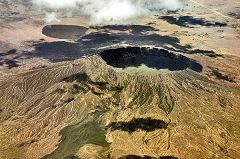
Longonot crater
Longonot mountain is actually an extinct crater in the Rift Valley, it is the highest of all Rift Valley volcanoes (2772 m). Longonot National Park is a fairly new park, created in the 1983 to preserve the interesting biodiversity around the crater area and the Naivasha basin. [photo: Brian Mc Morrow]


Lugards Falls
A crocodile is waiting for a prey to come in Lugards Falls. Despite of the name the 'falls' are in fact a series of rapids on the Galana River. [photo: Graham Dean]

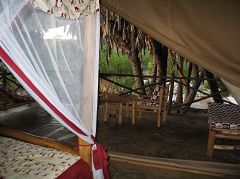
Man Eaters Camp
In the last few years of the 19th century two opportunistic male lions found the labourers working on the railway bridge over the Tsavo River, easy pickings. It is estimated that in a 10 month period over a 100 workers were snatched and devoured. The engineer in charge of the building project was Colonel Patterson and his book ?The Man Eaters of Tsavo? describes his trials and tribulations in bringing the culprits to book. He claims to have found their den, a small cave in a [...] [photo: Yvonne Matiba]

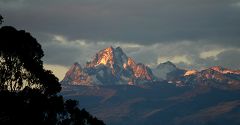
Mount Kenya
Mount Kenya - actually, an extint volcano - is the highest top in Kenya (5.200 meters) and the second highest in Africa, after Kilimanjaro (Tanzania). Its northern flanks across the Equator. The national park was established in 1949 and was inscribed by UNESCO as a World Heritage Site in 1997.

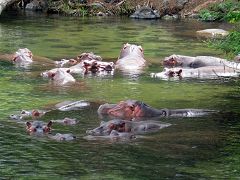
Mzima Springs
At Mzima Springs there are actually two large pools, connected by a stream of rapids and shaded by stands of raffia palms. The upper pool is long-shaped, favoured by the hippos, while the large-shaped one is preferred by the crocodiles. [photo: Yvonne Matiba]

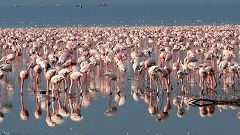
Flamingos at Lake Nakuru
Lake Nakuru national Park is the home to over a million flamingoes. Fleets of Lesser and Greater Flamingoes line the shores of Lake Nakuru giving it a pinkish appearance. Besides flamingoes, Lake Nakuru is home to other water birds including a variety of terrestrial birds numbering about 450 species in total.


White rhino at Lake Nakuru
Both the black and white species of Rhinoceros are in fact gray. The white rhino name is a corruption of the Afrikaans word for wide. The wide refers to the white rhino's broad upper lip that is designed for grazing.

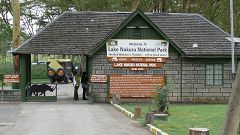
Lake Nakuru National Park Main Gate
Lake Nakuru National Park is the only park in Kenya that is completely fenced since it is located at only 4 km from Nakuru, the fourth largest town of Kenya

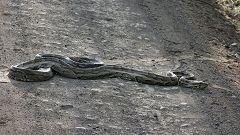
Python
Game-driving through the Lake Nakuru National Park, large sized pythons can often be seen as they're crossing the roads or dangling from trees.

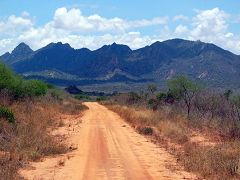
Ngulia mountains
View on the Ngulia mountains from the road to Ngulia Safari Camp [photo: Yvonne Matiba]

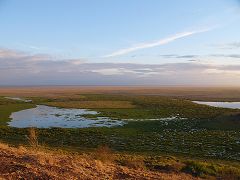
Enkongu Narok Swamp (Amboseli)
One of the many swamps that originates from the snowmelt and rains on Kilimanjaro.

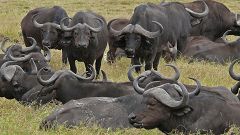
Buffalos in Amboseli
A group of buffalos on the Amboseli wetland. African Buffalo (or Cape Buffalo) is absolutely the most dangerous of the big five. An adult male might weights 600-750 kilos. Despite this vegetarian and somewhat pastoral appearance they are fearsome animals, killing more people than lions or crocodiles ever do.

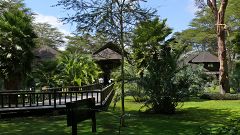
Ol Tukai Lodge
At the lodge you may find 80 chalet-style rooms; some of them viewing the wetlands, others facing the Kilimanjaro. To accomodate physically challenged guests, two rooms have been specifically designed according to EU standards.

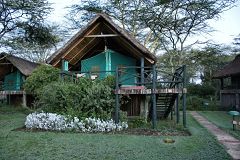
Sweetwaters Tented Camp
The Sweetwaters Tented Camp is located within the Ol Pejeta Conservancy Area. The camp is 25 kilometers west from Nanyuki, in Laikipia District. Sweetwaters is one of only four private game reserves in Kenya and features privileged seclusion and private game viewing. Thanks to its private status it also allows such unforgettable pleasures as night game drives and guided bush walks. [photo: Sinthrex]


Ol Pejeta Conservancy
Ever since 1974, Morani, a tame black rhino, lives in its own sanctuary within Ol Pejeta Conservancy, located few kilometers away from the Sweetwaters Tented Camp. The young rhino was brought to the ranch after some poachers killed its mother. [...] [photo: Patty Chang]


Thomson falls
Thomson's Falls originate where the Ewaso River plummets 75 metres into a boulder-strewn gorge discovered in 1880 by the explorer Joseph Thomson. [...]

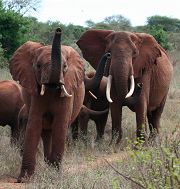
Tsavo West
The red elephants of Tsavo; due to the reddish terrain, everything in Tsavo turns red [photo: Laura Weinkam]


 ...contact
...contact